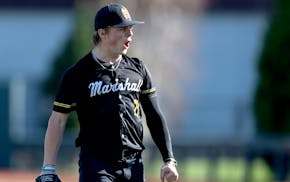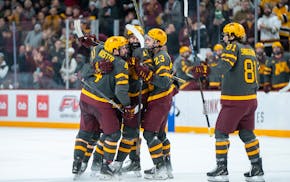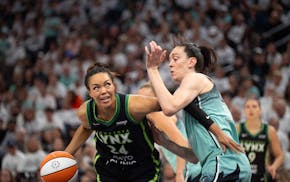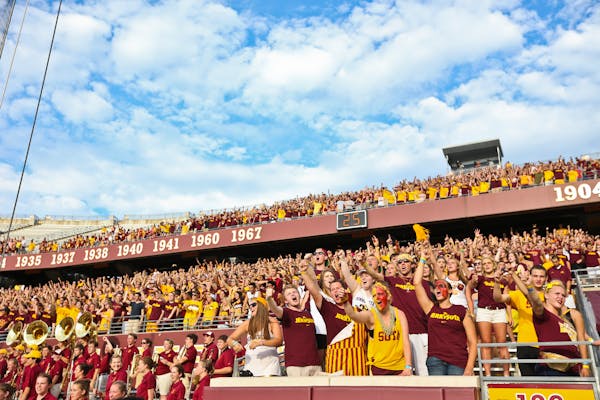Two hours before kickoff, the three-story Sigma Pi fraternity house was vibrating.
A dozen fraternity members, many wearing University of Minnesota football jerseys and shirts, were on the front lawn tossing a football. Hamburgers were on the grill, Bruce Springsteen songs pounded through speakers hanging out a window, and the crowd headed to the game already was streaming by.
The game — Sigma Pi is the closest fraternity to 50,000-seat TCF Bank Stadium — was just a block away.
But Michael Schaak, a kinesiology major who wore a "J-e-r-r-y-s-o-t-a" T-shirt, a nod to Gophers head coach Jerry Kill, said he had things to do and was not going. Eric Kuehn was going but said he had no idea who the Gophers were playing. Cole Sundquic, a senior biology major, said he normally goes — he was not this day — and complained of the slow pace of the games.
Even among the school's most ardent football fans, members of the fraternities and sororities that line University Avenue near the five-year-old stadium, there is head-scratching about why the school has trouble filling the stadium's student section. Before the first game in late August, school officials said packages had boosted student season-ticket sales for football to 5,043, roughly half of the 10,000 seats allotted for students.
The phenomenon is not confined to Minnesota. There have been empty seats at games in the Southeastern Conference, the country's premiere college football league. And two weeks ago, with Michigan State hosting Nebraska in a pivotal game, Michigan State's athletic director took to social media, criticizing students who were leaving the game early.
As schools rush to enhance the "Game Day" experience for students by offering cheaper tickets and Wi-Fi in stadiums, there are indications they may be offering only partial solutions. There are the usual theories as to why it is happening, including students' ability to get a better, cheaper view of the game on their own big-screen TV. But there is also a sense that something more fundamental is afoot, and that students, if they go, see games as something they may stop momentarily to see.
"We're going to get food," announced Audrey Hamand, as she and two friends left the stadium at halftime last Saturday, seeming not to care that the Gophers held a slim 14-10 lead in a big game against Northwestern. Though much of the stadium was full, the student section had a large swath of empty seats, and even midway through the third quarter groups of students casually entered — and exited — the stadium.
School officials insist they are chipping away at the problem and point out that student season ticket sales are up this year by more than 25 percent.
With the school getting $11.5 million in football ticket money last year, herding fans — including students — to the games is vital for other important revenue streams, including concessions, souvenirs and parking.
In its own attempt at a creative solution, Minnesota offered student packages for men's hockey and men's basketball tickets — but only if students also bought slower-selling football tickets. But after students and Gov. Mark Dayton earlier this month complained — the governor said he was "appalled" by the practice — the school adjusted its policy. Forty-two students were given a refund, the school said.
"The characterization that we were forcing any students to purchase tickets is untrue," said Chris Werle, a school athletics spokesman.
Highlights over game?
Joshua Rosenthal, the president of Sigma Phi Epsilon, said some in the fraternity will get up at 6 in the morning on game days to socialize but will take naps when the game starts. Rosenthal said he goes to half the home games. For the Middle Tennessee State game in September, he did not enter the stadium until halftime and then exited by the end of the third quarter. Staying longer, he said, "wasn't worth my time."
Frankie Szeto, a junior and Sigma Pi member, said he goes to most games and is optimistic that more student support will come. "It's a lot more than what it was two years ago," he said, wearing a maroon-and-gold Gophers shirt. "You can't get that same crowd experience sitting on a couch."
But Jim Kahler, the director of Ohio University's Center for Sports Administration, said the job is to excite students who have little interest in committing four hours on a Saturday to attending a football game. "This is a generation that grew up with ESPN, [and] they're used to seeing highlights," he said. "They want it now.
"To sit there and wait for the outcome of the game almost seems to be asking too much."
Randal Gast, a co-owner of a nearby Qdoba fast-foot outlet, had another opinion as he gave away coupons to students before a recent game: It's expensive to attend. "Hey, they came running out because I gave them coupons for breakfast for a buck," he said. "What does that tell you?"
Football season tickets for students this year had been $90, and student tickets for Saturday's game are $20.
Former coach wonders why
Even Glen Mason, the former Gophers football coach who is an analyst for the Big Ten Network, is amazed. "I am surprised that the students haven't taken to TCF Stadium and football back on campus" after nearly 30 years of being played in downtown Minneapolis, he said. Mason said the school has more work to do to convince students that going to games can be fun. "Fun trumps [everything, even] winning," he said.
That's not to say the school's students do not get excited about events at the stadium. With the school playing its homecoming game this Saturday against Purdue, Nathan Waldvogel said students and the general public rushed to buy 10,000 tickets — not to the game but to a homecoming concert the night before in the stadium. "It was the fastest that we've sold out," said Waldvogel, a school official.
At the brown-brick Sigma Chi fraternity, the tie to the school's former football greatness can been seen on a plaque facing University Avenue. The building is named after Bronko Nagurski, the school's legendary football player from the 1920s and a one-time fraternity member. Near a fireplace inside the building, there are black-and-white pictures of Nagurski holding his leather helmet and hurdling tacklers. "Definitely jazzes it up," fraternity President Isaac Waalen said of the pictures.
Waalen asked a group standing nearby whether many fraternity members would be going to the Northwestern game, the next day.
No, came one loud reply.
But another voice just as loudly disagreed. "Yeah, they will," he said. "It's a huge game."

Duluth Marshall's Marsolek records 17 strikeouts in two-hit shutout over Proctor

Former Lakeville South hockey forward Pritchard flips commitment to Gophers

Fleury says his retirement is still sinking in after Wild's playoff exit

